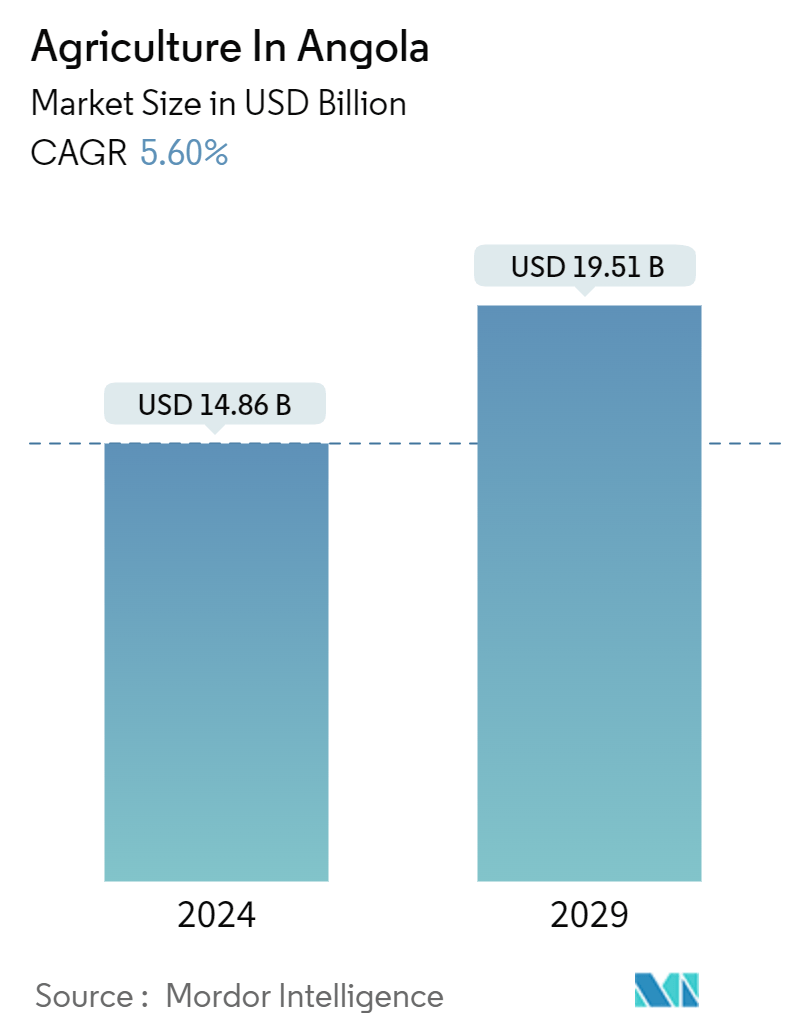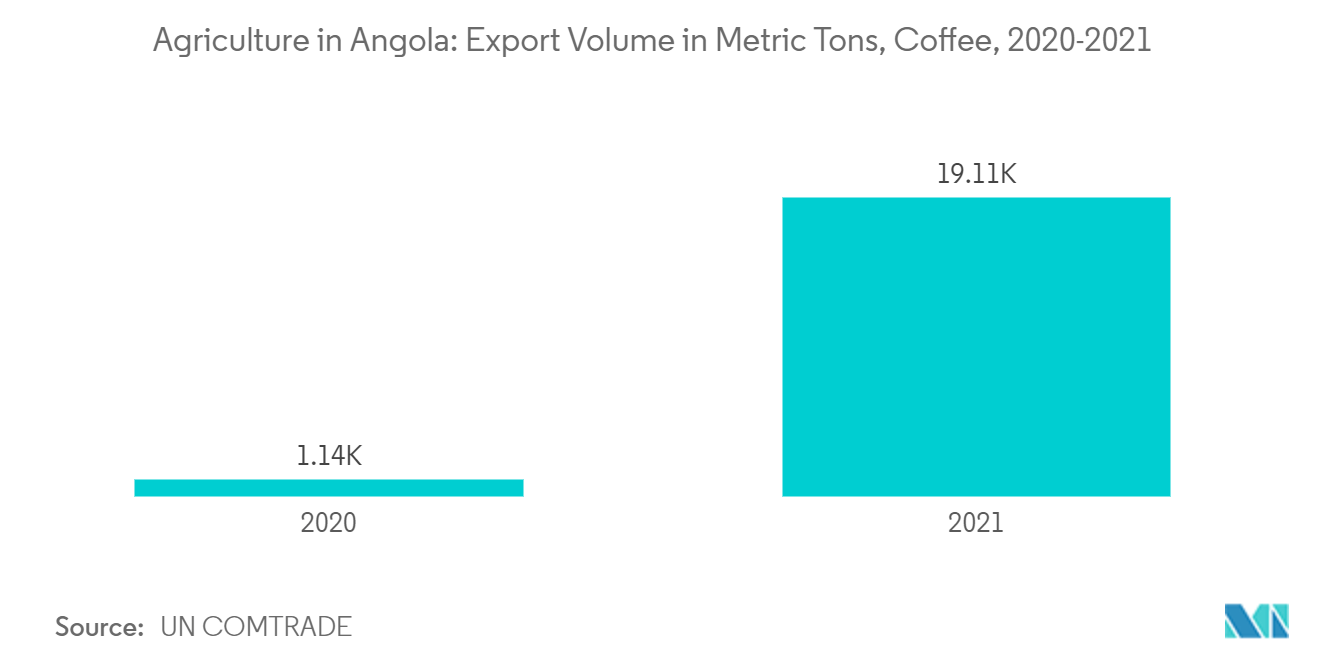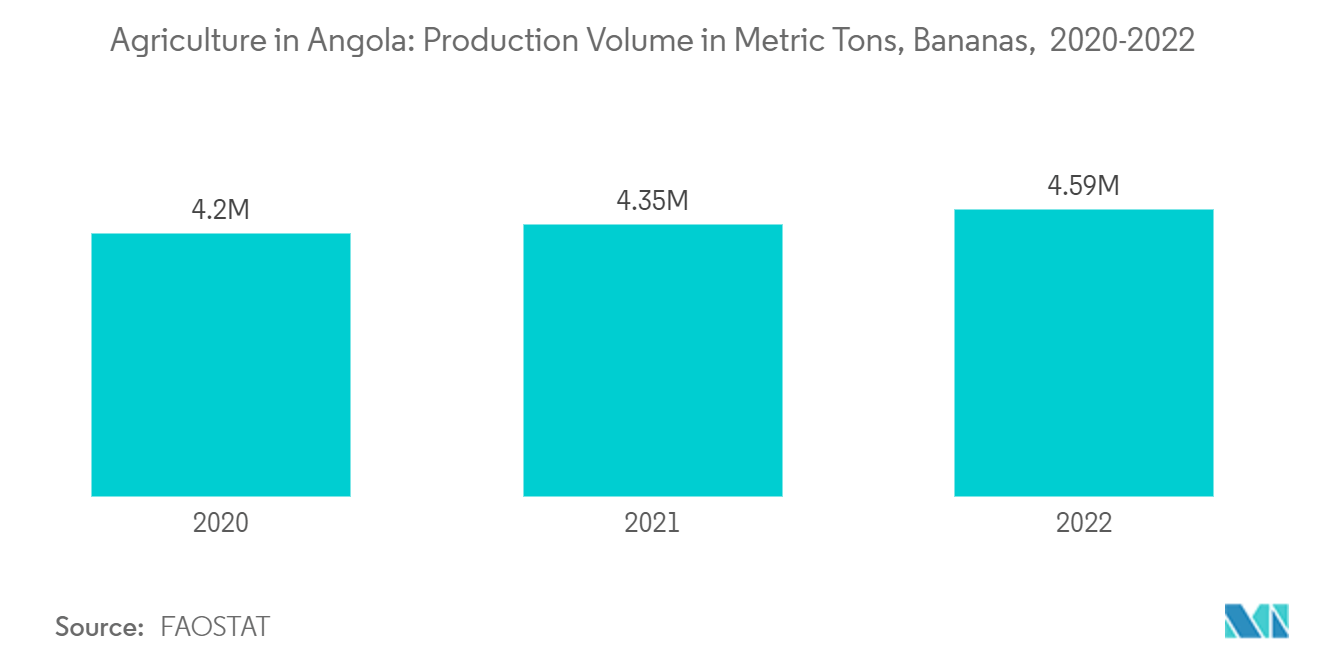Angola Agriculture Market Size

| Study Period | 2019 - 2029 |
| Base Year For Estimation | 2023 |
| Forecast Data Period | 2024 - 2029 |
| Market Size (2024) | USD 14.86 Billion |
| Market Size (2029) | USD 19.51 Billion |
| CAGR (2024 - 2029) | 5.60 % |
Major Players*Disclaimer: Major Players sorted in no particular order |
Angola Agriculture Market Analysis
The Agriculture In Angola Market size is estimated at USD 14.86 billion in 2024, and is expected to reach USD 19.51 billion by 2029, growing at a CAGR of 5.60% during the forecast period (2024-2029).
Angola has significant agricultural potential among Southern African countries due to its abundant water resources, favorable climate, and extensive arable land. However, much of this potential remains untapped, with only 5.9 million hectares cultivated in the 2020-2021 season out of the 35 million hectares of arable land, as per the World Bank’s estimates. The country's agricultural production is insufficient to meet the demand, leading to the need to import over half of its food requirements. The country has many agroecological zones that are suitable for the growth of a wide range of tropical and subtropical crops for both domestic and export consumption.
Angola’s main agricultural produce includes cassava, corn, beans, potatoes, sweet potatoes, soy, bananas, coffee, rice, and other vegetables and fruits. The hills and valleys, particularly in the southern provinces, are the most productive. The rainy season lasts from October to May and is considered the best time for vegetable cultivation. Tomatoes are grown throughout the dry season, which lasts from June to September. According to the Food and Agricultural Organization, tomato production in Angola was 560,618 metric tons in 2019, which increased to 587,785 metric tons in 2022. Angola's favorable climatic conditions for crop production drive the market's growth during the forecast period.
The Angolan government has implemented various initiatives to promote economic diversification by focusing on the agriculture industry and encouraging private sector growth, which could lead to significant change in rural agricultural areas. For instance, the government launched PRESILD (Program for Restructuring of the Logistics and Distribution System of Products Essential to the Population) in 2022, aiming to bolster domestic agricultural production and distribution by enhancing nationwide infrastructure.
Furthermore, the excessive use of chemical pesticides results in residue on agricultural produce, including cereals, pulses, fruits, and vegetables. Consuming this residue poses health risks, including potential long-term effects such as developmental issues, hormonal disruptions, and increased risk of certain diseases, which are expected to impede the market's growth during the forecast period.
Angola Agriculture Market Trends
High Regional Trade of Coffee Boosting the Angolan Market
In Angola, cereals, pulses, fruits, vegetables, and cash crops contribute to the country's agricultural production. Coffee is a significant crop in Angolan agriculture, with Angola being a leading coffee producer as well as exporter before the Civil War. To revive the competitiveness of Angolan coffee, the Angola Ministry of Agriculture implemented strategic policies. For instance, the government established the Angolan National Coffee Institute (INCA) to attract private investors for public-private partnerships (PPPs) and the development of a dedicated 'coffee fund' to support smallholder farmers. The focus on coffee is evident in the country's coffee exports, with 18,824 metric tons exported in 2023 compared to 1,312 metric tons in 2019, according to ITC Trade Map. In 2023, major export destinations for Angolan coffee included Portugal, Morocco, Spain, and Germany, with Portugal accounting for 37.8% of the total export value. Moreover, the country exported both raw and unprocessed coffee in the form of ‘cafe mabuba’ (dried cherries or parchment coffee) or ‘cafe commercial’ (green coffee).
According to FAOSTAT, the country harvested 16,767 metric tons of green coffee from 51,151 hectares of cultivable land in 2022, compared to 13,285.5 metric tons from 40,222 hectares in past years. Most of the coffee is produced in the Northern and Central regions, with the Uíge and Cuanza Sul provinces as the main producing regions. Angola produces two varieties of coffee, such as Coffea canephora, often known as Robusta26, and Coffea Arabica, also known as Arabica. Angolan Robusta coffee is well-liked for its distinct flavor and highest quality among producing countries. This is most likely owing to local farming practices, which often grow coffee in shadow, as well as environmental circumstances such as high altitude (e.g., some plantations are located around 1,100 meters above sea level) and soil type.
Besides, various international coffee growers have made significant investments to boost the country's coffee exports. For instance, Fazenda Vissolela, a prominent international coffee farm, planted 360 hectares of coffee in 2023 to expand to 1,000 hectares by 2027. Additionally, Fazenda Vissolela collaborates with 250 small-scale farmers to help local communities thrive. About 15% of the green coffee is sold under the brand Cafe Romana in the local market, while the rest is distributed to global partners like Nestle and Delta.
Therefore, the government's efforts, along with the involvement of foreign entities, will boost the country's coffee exports in the coming years.

Fruits and Vegetables are the Most Produced Commodities in the Angolan Market
Angola has experienced significant growth in its population, resulting in an increased demand for agricultural products, especially fruits and vegetables. To reduce reliance on imports and support local production, the government has been heavily investing in increasing its domestic production capacity. Moreover, Angola has ample resources such as land, water, soil quality, infrastructure, and climate to enhance its fruit and vegetable industries. In addition, Angola's seasons align with the Southern Hemisphere, with a colder period from June to September, unlike countries in the Northern Hemisphere like Costa Rica, Egypt, and Morocco, which give the country several climatic advantages.
Bananas, avocados, and citrus fruits are the major fruits produced in the country. Angola is the largest banana producer in Africa and the seventh largest worldwide, with an annual supply of over 4 million metric tons. According to FAOSTAT, in 2020, the country produced 4,204,538 metric tons of bananas, which rose to 4,589,099 metric tons in 2022. The Lobito Corridor, Huambo, and Benguela provinces are famous for their ideal climate for growing fruits. In Benguela, located at lower altitudes, tropical fruits like bananas, pineapples, and mangoes are grown well. Meanwhile, in Huambo, which has altitudes exceeding 1,200 meters, crops like avocados and citrus fruits flourish. Furthermore, in 2021, the Angolan government received funding from the African Development Bank for the development project of agricultural value chains in Cabinda province to make payments for small agro-processing equipment for banana production.
Likewise, the production of vegetables, such as tomatoes and onions, is on the rise in the country. According to FAO, the country produced 587,785 metric tons of tomato in 2022, recording a 4.62% increase over 2019. The popularity of dietary diversity and cultural cuisine in the country ensures a steady market for various vegetables, boosting the overall market.
Further, the conducive government policies are promoting the production of fruits and vegetables in Angola. The Ministry of Agriculture and Rural Development in Angola is collaborating with the private sector to achieve goals such as distributing seeds and tools and rebuilding rural infrastructure. The government has also supported the creation of large agricultural projects and businesses such as Gesterra SA, Aldeia Nova, and the Quiminha Project (PIDARQ). These initiatives are aimed at boosting private sector participation in agriculture, including the production of fruits and vegetables, to bolster the agricultural market in the country.

Angola Agriculture Market News
- January 2023: The Government of Angola partnered with Technologies for African Agricultural Transformation (TAAT) to provide technical assistance to the government through the African Development Bank(AfDB)-funded Cabinda Province Agriculture Value Chains Development Project (CPAVCDP).
- December 2023: The Board of Directors of the African Development Bank Group approved a loan of USD 105.19 million to Angola to implement the Agriculture Sector Reform Programme. The program aims to strengthen agriculture policies and the business environment to improve food crop production in Angola.
- September 2022: The World Bank and the French Agency for Development provided USD 230 million for the Angola Commercial Agriculture Project (PDAC). The project aims to increase agricultural productivity and market access to more commercial farms.
Angola Agriculture Market Report - Table of Contents
1. INTRODUCTION
- 1.1 Study Assumptions and Market Definition
- 1.2 Scope of the Study
2. RESEARCH METHODOLOGY
3. EXECUTIVE SUMMARY
4. MARKET DYNAMICS
- 4.1 Market Overview
-
4.2 Market Drivers
- 4.2.1 Growing Trend Toward Healthier Diets
- 4.2.2 Supportive Government Initiatives
- 4.2.3 Technological Advancements in Agriculture
-
4.3 Market Restraints
- 4.3.1 Lack of Storage and Processing Units
- 4.3.2 Overuse of Agrochemicals in Agricultural Production
- 4.4 Value Chain Analysis
5. MARKET SEGMENTATION (Production Analysis by Volume, Consumption Analysis by Value & Volume, Import Analysis by Value & Volume, Export Analysis by Value & Volume)
- 5.1 Cereals and Grains
- 5.2 Pulses and Oilseeds
- 5.3 Fruits and Vegetables
- 5.4 Commercial Crops
6. INTERNATIONAL TRADE AND PRICE SCENARIOS
- 6.1 Onion
- 6.2 Potato
- 6.3 Tomato
- 6.4 Cassava
- 6.5 Garlic
- 6.6 Cauliflower
- 6.7 Beans
- 6.8 Eggplant
- 6.9 Lemon
- 6.10 Apple
- 6.11 Banana
- 6.12 Grapes
- 6.13 Strawberry
- 6.14 Watermelon
- 6.15 Dates
- 6.16 Olives
- 6.17 Coffee
7. Regional Analysis
- 7.1 PESTLE Analysis
- 7.2 Supply Chain Analysis
- 7.3 Government Policies
8. Competitive Analysis
- 8.1 Distribution Network and Retail Analysis
- 8.2 List/Profiles of Key Players
9. MARKET OPPORTUNITIES AND FUTURE TRENDS
** Subject To AvailablityAngola Agriculture Industry Segmentation
Agriculture encompasses cereals, oilseeds, pulses, commercial crops, fruits, and vegetables. The study analyzes the agricultural industry of Angola and predicts the growth of its various segments. The Angolan agriculture market is segmented into cereals and grains, pulses and oilseeds, fruits and vegetables, and commercial crops. The report includes a production analysis (volume), consumption analysis (value and volume), export analysis (value and volume), import analysis (value and volume), and price trend analysis. The report offers the market sizes and forecasts in terms of value (USD) and volume (metric tons) for the abovementioned segments.
Angola Agriculture Market Research FAQs
How big is the Agriculture In Angola Market?
The Agriculture In Angola Market size is expected to reach USD 14.86 billion in 2024 and grow at a CAGR of 5.60% to reach USD 19.51 billion by 2029.
What is the current Agriculture In Angola Market size?
In 2024, the Agriculture In Angola Market size is expected to reach USD 14.86 billion.
What years does this Agriculture In Angola Market cover, and what was the market size in 2023?
In 2023, the Agriculture In Angola Market size was estimated at USD 14.03 billion. The report covers the Agriculture In Angola Market historical market size for years: 2019, 2020, 2021, 2022 and 2023. The report also forecasts the Agriculture In Angola Market size for years: 2024, 2025, 2026, 2027, 2028 and 2029.
Farming in Angola Industry Report
Statistics for the 2024 Farming in Angola market share, size and revenue growth rate, created by Mordor Intelligence™ Industry Reports. Farming in Angola analysis includes a market forecast outlook to 2029 and historical overview. Get a sample of this industry analysis as a free report PDF download.



